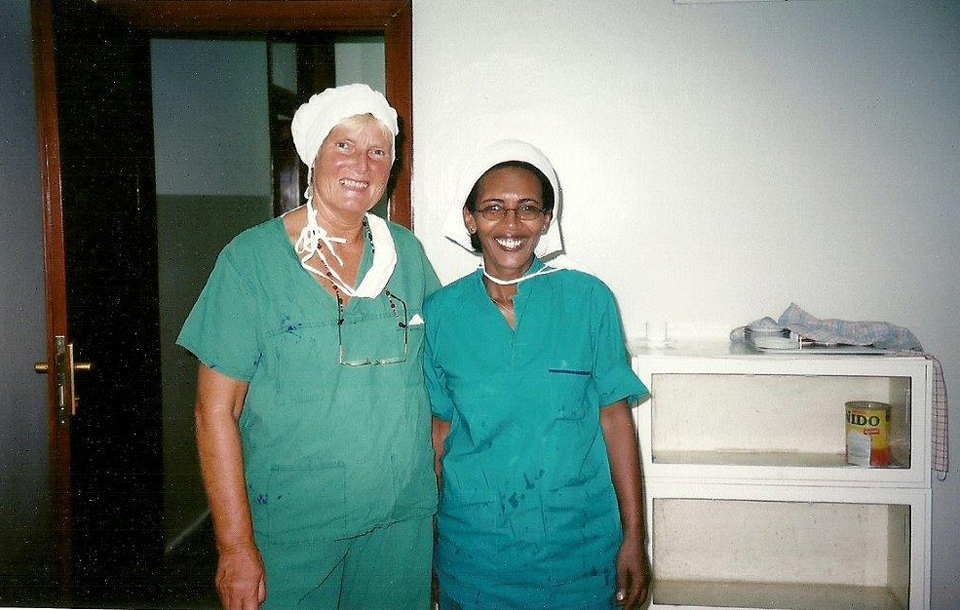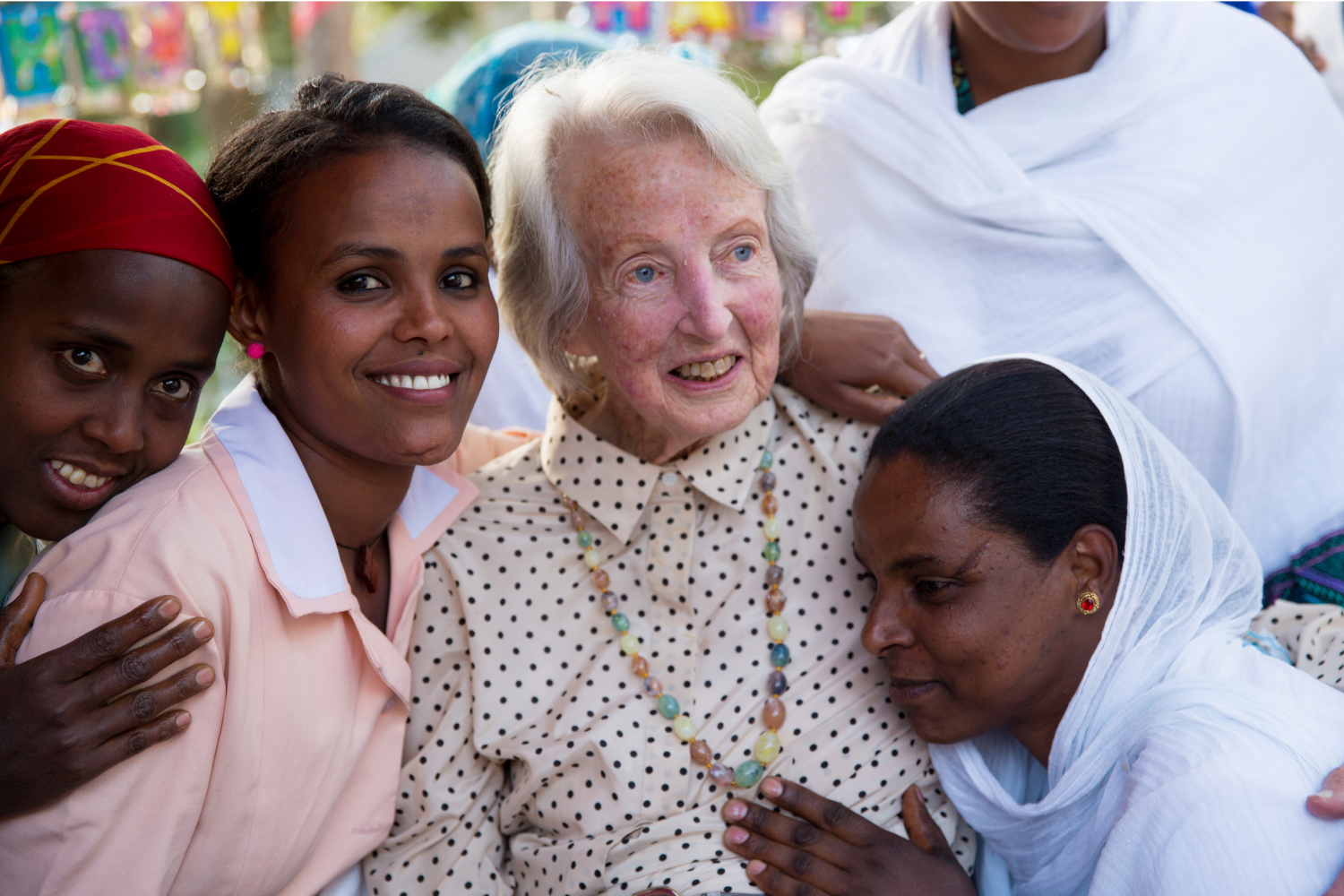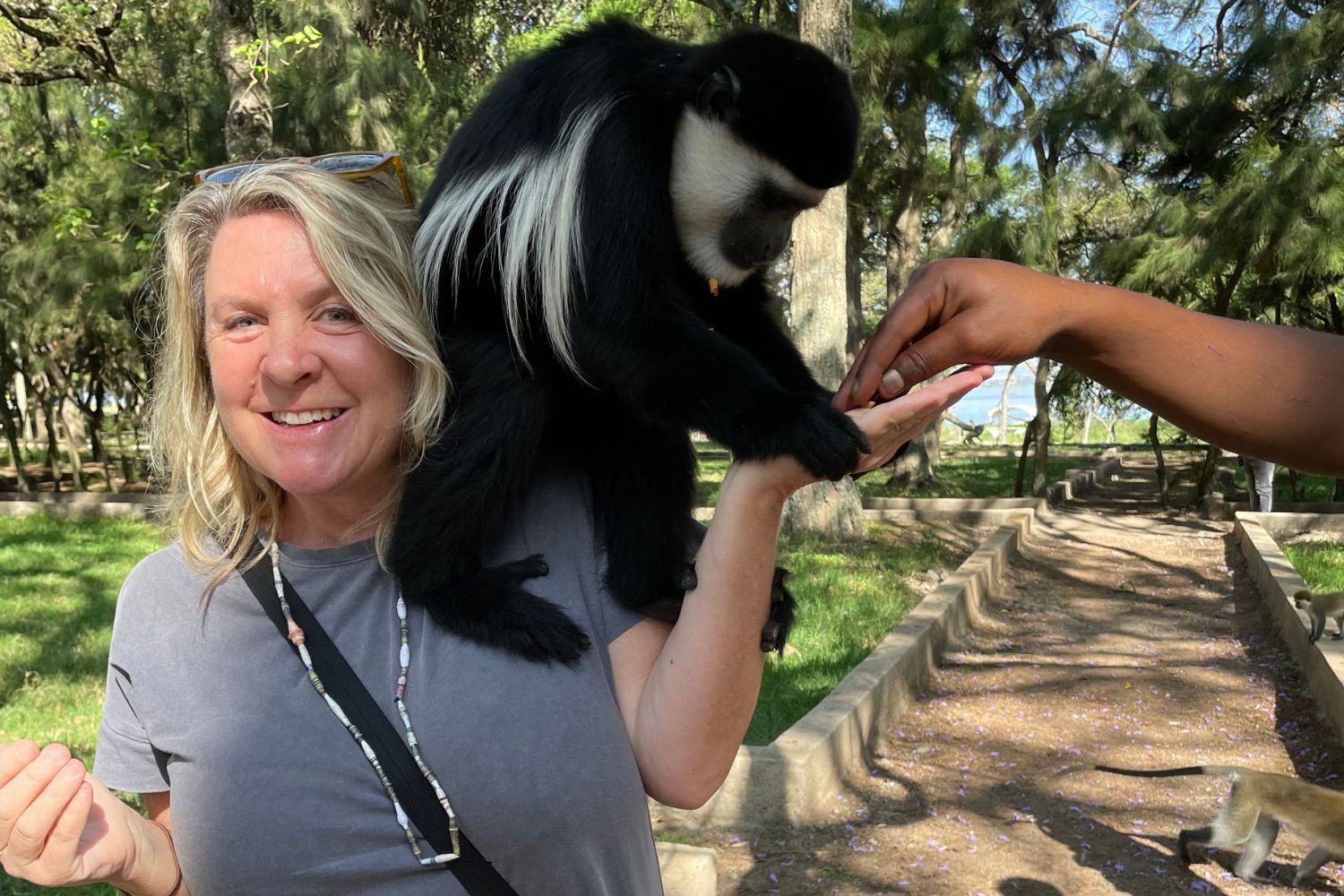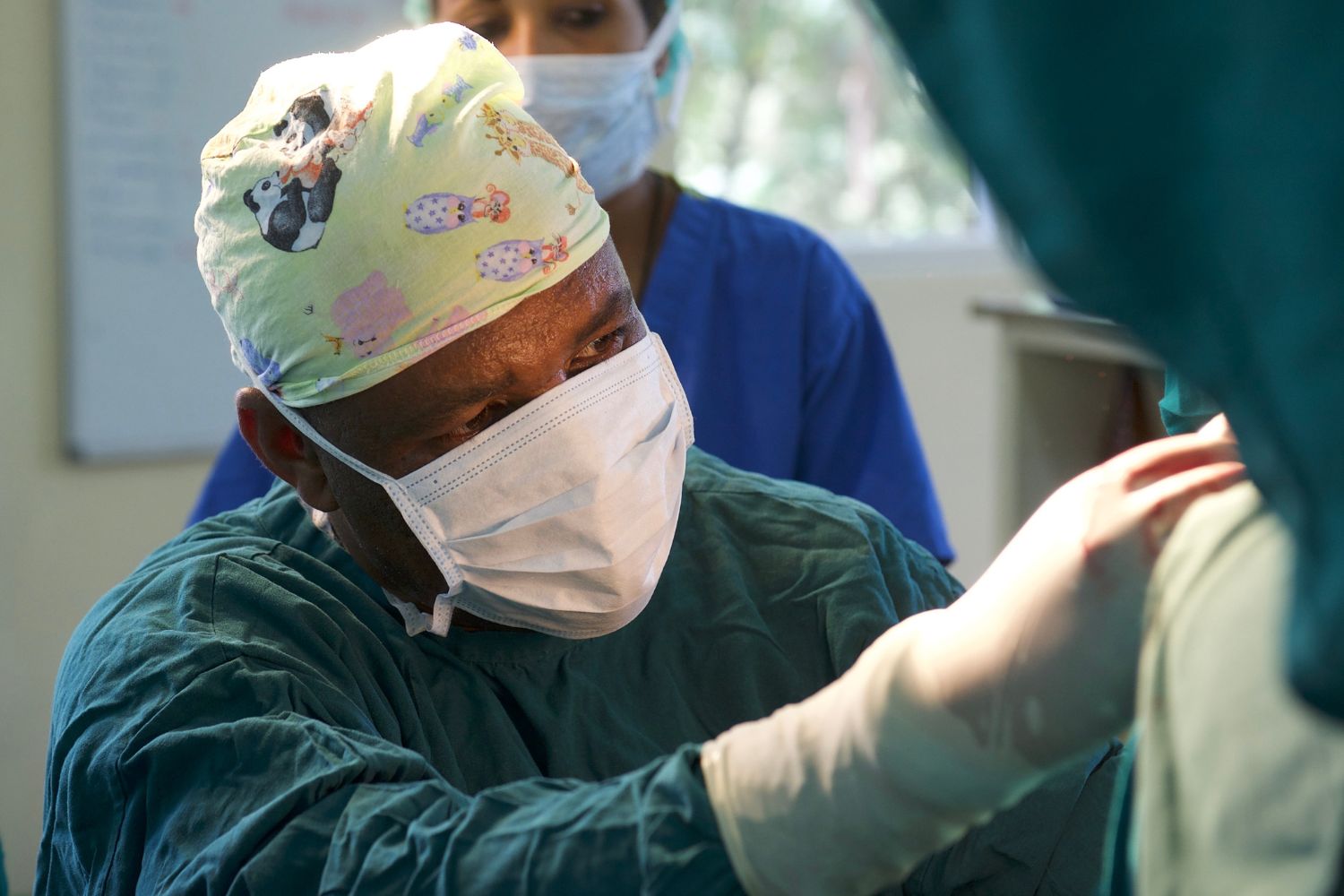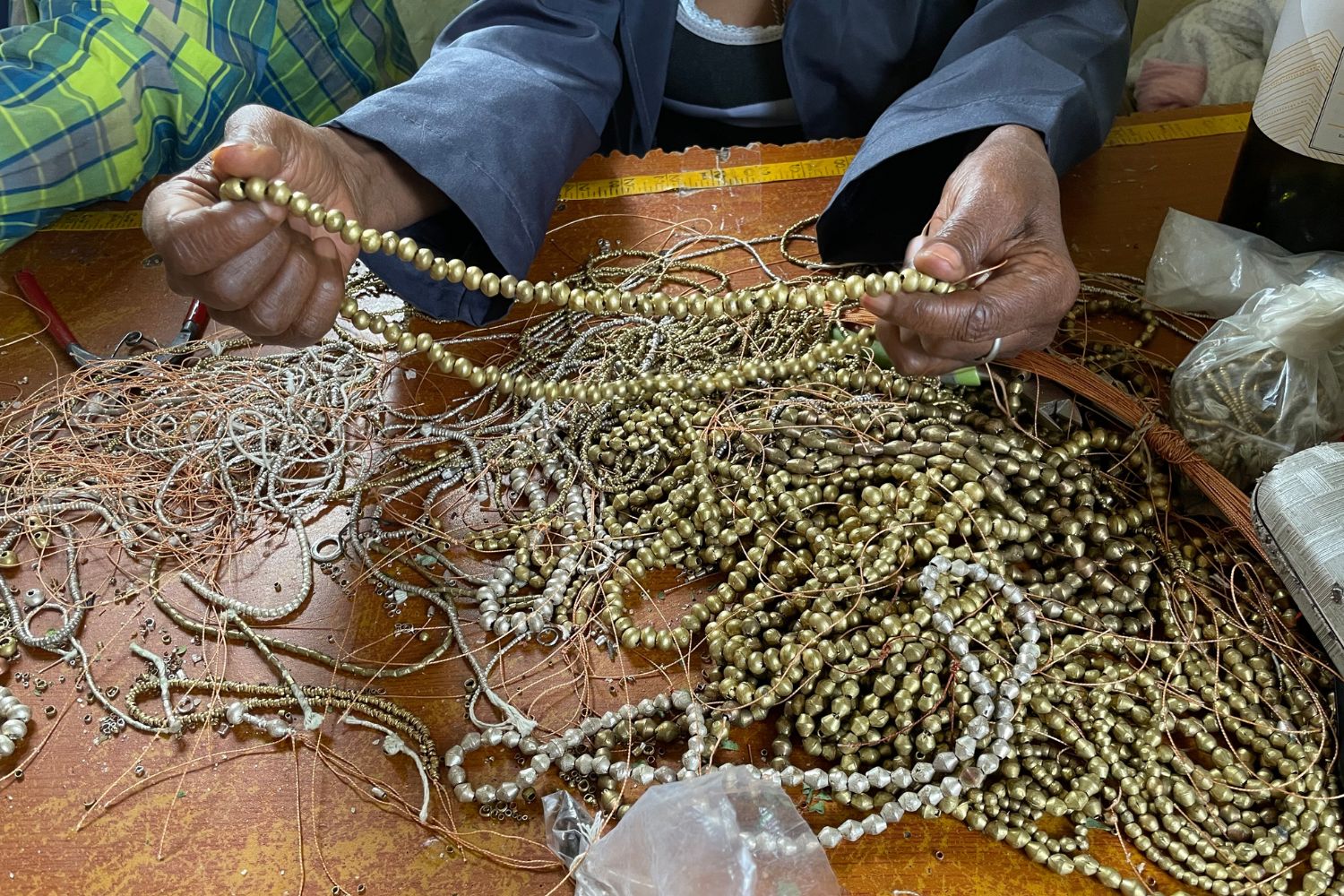Prilli Stevens was the Chief Professional Nurse in the Stoma therapy Unit at Groote Schuur Hospital in Cape Town, South Africa; she retired in 2005. Prilli first met Dr Catherine Hamlin in 1995. Written in 2005, below is Prilli Stevens’ account of working with Catherine.
It was in 1993 that I first heard of the amazing fistula hospital in Addis Ababa. I was attending a day seminar in England and listened to a consultant urologist from the Hammersmith hospital presenting the wonderful work done by the founding gynaecologists Catherine and Reg Hamlin – who back in 1953, whilst working in Addis as gynaecologists, recognised the plight of the hundreds of women with obstetric fistula. Because of the numbers (a suggested number being 3,000 new cases annually in Ethiopia alone!), they decided to pioneer a fistula hospital – and together, through sheer hard work, raised funds to create and build the Addis Ababa Fistula Hospital – which they completed in 1975. Together, they annually repaired in excess of 1,500 fistulas. This is only part of the story, for it is the way they care for the patients and employ the many girls they have cured as carers that is perhaps the most magical part of this unique facility.
I was so captured by the work they were doing that in 1995 I wrote to Catherine Hamlin and invited her to come and address our South Africa Stoma therapy conference. This she willingly did, and thus a friendship between us has flowered and grown! Her poignant stories of Ethiopia and its mountainous and at times inhospitable terrain – rugged roads and rushing rivers – with poor access to any hospital facilities may make one wonder why she and her husband would give up the comfort of Australia where they had trained to dedicate their lives to the fistula girls and to Ethiopia. But once you have met Catherine (sadly her beloved Reg passed on in 1993), you cannot fail to realise that you are in the presence of another Mother Teresa – such is her compassion and total life dedication to the cause of the fistula patients.
The patients themselves are often so desperate and outcast by their own society that they walk for many days or weeks to reach the care of the hospital. Their return to dryness may tae as long as a year, for many are not only severely damages with the fistulae but are also malnourished and severely debilitated – suffering foot drop and pelvic fixation due to long days of squatting during the ill-fated delivery period. Many will have been rejected by their husbands – and if infertile – will be unacceptable in the future. The psychological aspects of their care are paramount at Catherine’s facility – and much understanding, love and support is given to them.

Catherine and Prilli
In 2002, I receive a phone call from Catherine asking if I could come and visit her, and help establish stoma therapy for patients who had failed surgical repair and required or had permanent stomas – I jumped at the opportunity. I little guessed how life-changing the experience was to be for me – for I was to be exposed to such a unique group of caring individuals – all driven by a total love of their fellow man and guided by a God who they never doubted would come through for them – however mammoth their task seemed to be!
A battery of inoculations and an air ticket in hand saw me leave the comfort zone of the tip of Africa to fly up into Ethiopia and a different world. My suitcase contained, amongst other things, two handmade educational dolls – made lovingly for me by a urostomy patient of mine in the Cape. Such an aid I felt would help break down language and cultural barriers when trying to explain anatomy and the procedures. I had managed to cajole some ureteric catheters, gloves and sutures from various sources and a wide selection of pouches, paste and belts. I included some urostomy pouches, which were to be worth their weight in gold!
I was met by the hospital liaison officer, Sister Ruth Kennedy – a wonderfully, dynamic sister who previously worked in Chad and had run the Ethiopian Safe Motherhood programme. She is devoutly Christian and contributes enormously to the running of the hospital, as well as having a portfolio to raise funds from many international sources. She is immensely efficient – and knows everyone and everything about the hospital and its occupants! Catherine herself is the mother and maestro: most respected of people, lovingly cared for in her own accommodation – a lovely cottage in the grounds – where her faithful maid and guards look after her as if she was the Queen. Wherever she goes, she reaches out to those around her – all of whom have put their trust in her expertise to fix their desperate plight. Her love of nature is obvious as the gardens are a blaze of colour and receive the attentions of the gardener delegated solely for the task. A borehole has enable the hospital to have adequate water when others in the country have little or none.

Meeting Catherine, Dr Ambaye and Dr Browning on my first day at the Addis Ababa Fistula Hospital
My accommodation was a ‘tukul’ – or rondavel with a tin roof – and in the hospital grounds. The patients are accommodated all round the grounds and I was enchanted by listening to them chattering to each other in Amharic and a host of other languages. The daily washing of their bedding by hand was a memory I shall long carry! For the girls not yet in the main ward, there is a hostel type accommodation with as many beds as possible squeezed in – their few belonging hanging above the beds in carrier bags whilst they await their surgery. All are incontinent – they do not have pads – so little puddles are to be seen everywhere, discreetly hosed by a gentleman whose sole task appeared to be to keep the grounds fresh and wholesome – which he did admirably.

Sister Ruth Gadessa in the operating theatre
The hospital itself comprises one large Florence Nightingale 60 bed ward and one smaller 12 bed postoperative high care ward. This is always 100% full and the care is given by four trained nurses and many former patients who have stayed on as carers and assistants. These girls carry out many roles such as autoclave technicians, theatre assistants and scrub nurses. By far the most famous of these is the remarkable Mamitu Gashe – one of Hamlin’s first fistula patients who has become a skilful surgeon and carried out over 1000 fistula repairs! She learnt her skills assisting Dr Reg Hamlin and is so competent that the Royal College of Surgeons of England have bestowed a gold medal on her in recognition of her skills! Whilst I was there, I watched in awe her operating technique and revelled in the welcoming way she shared her many skills in the postoperative management setting. The other girls work in a variety of settings in the ward and the outpatient, pharmacy and physio rooms. Not only do they achieve great skills but also they are an inspiration to new patients – and all possess the philosophy of the hospital, which is to respect the dignity of every human, whatever their condition.

With fistula surgeon Mamitu Gashe
Dr Hamlin is now in her late 70s but still operates, having trained other postgraduate gynaecologists from Ethiopia who pass through her facility as part of their postgraduate experience – she chose Dr Ambaye, a young female gynaecologist, to be her successor. She now leads the surgical team with the assistance of three Ethiopian surgeons and one Australian who has been with the team for the past six years. Whilst I was there, he and Mamitu took off for a hospital ship moored on the West Coast of Africa – and between them, operated and repaired twenty-four fistula patients in five days!

With Dr Ambaye, the Chief Fistula Surgeon at the time
My trip to the theatre was quite mind-blowing – firstly, because there are four tables in the theatre, and secondly, because the patients walk into theatre, climb onto the bed and have spinals put in. Should an anaesthetic be required, this is administered by the theatre sister Tinedem, another very competent nurse. A busy day with fifteen cases was made even more fascinating as I watched the recycling going on: everything is re-usable from swabs to gloves. Catheters are put in but there are no catheter bags so when monitoring output is was intriguing to note the catheter hanging in a glove – thus, output would be “One finger full, two fingers etc. etc.” Swabs were quickly washed, bleached and put onto a table in the garden in the sunshine to dry. Once dry, into the ward where recovering patients would smooth them out and pack them into drums for autoclaving. The girls assisting the four surgeons, one of whom was Mamitu, were all ex-patients and their competence was a joy to behold! The views into the garden through the theatre windows made it a surreal day!

Aberash helping in the stoma therapy clinic
Peri-operatively, the ward is always full of girls lying quietly with their catheters draining freely into a kidney dish between their legs. These dishes are emptied into a bucket alongside the bed. They are given a bottle of water which is replenished regularly by the carers. These girls deal with their every need and support as can only be given by those who have experienced the same anguish. The great day dawns when the catheter is clamped, the bladder fills, and the lack of urinary leakage noted, the catheter is removed is perhaps the finest experience of all! Gentle mobilisation outside the ward, where some thirty girls compare notes. For some the tell tale puddles mean that perfection has not yet been achieved, and for some further surgery may be required. But for the others-who may have suffered untold degradation and despair their happiness is there for all to behold.

A teacher conducting reading class in the garden
The hospital grounds are always a colourful sight as the girls proudly wear their hand knitted multi coloured blankets presented to them by the Hamlin trust from Great Britain, whose Birmingham chairman’s wife had carried them from England that week in her suitcase! A teacher is on hand to teach the girls some basic educational skills such as the letters of the alphabet, hygiene, and knitting. Those with impaired muscle or skeletal systems are taught some physio in the physio department, where some clever aids have been home made to encourage strengthening of wasted muscles and foot drop. Slowly but surely, the initially despondent and desperate young girls warm to the love and attention- they plait each other’s hair and chatter amongst themselves in one of the 200 dialects available – although the main language spoken is Amharic.
At all times the dignity of the girls is preserved and the overall considerations of their social and medical plight taken into consideration, especially when planning their going home. This is not necessarily an easy undertaking and might take several days or weeks-involving donkeys, camels, and buses and walking. Prior to leaving the hospital, each girl is taught the importance of early detection of a pregnancy in the future and told to start walking to a hospital once the baby moves inside her. She is given a card with her fistula history to present to the hospital. Further, she is encouraged to spread the word amongst the girls in her village.

Stoma therapy patients at Desta Mender
Sadly, in spite of a brilliant 92% success rate in repairing these often huge problems, there are at this time 52 girls with permanent stomas living in the fistula facility – unable to go home because of lack of available consumable stock or any means to sustain this for them should they leave the confines of Addis. This created quite a logistic problem and has led to the purchase of land and the building of a wonderful farm called Desta Mender (“Joy Village”), 25 kms outside Addis. This was a highlight of my visit as I went there to meet the girls and see their lovely accommodation. Catherine’s brother Jock and his wife Louise live at the farm – Jock being a retired farmer from Australia and Louise a nurse. She and I were thrilled to discover that we both trained at Barts Hospital in London, and in fact had just overlapped and had many mutual friends! Louise was thrilled to have someone teach her the basics of stomas and their care, as she had been dropped into the role of nurse and “Mother” to the girls and yearned to be able to help them. She is a remarkable woman and like everyone else totally committed to her new life- although it has meant leaving her homeland and being alone with nothing but a wind-up phone which occasionally goes on the blink between her and civilisation!

Visiting stoma therapy patients
I established a wonderful rapport with the girls, who began the time with a tea ceremony to welcome me, and then we had a useful orientation utilising the dolls I had brought with me. One of the nurses from the fistula hospital provided the translation! Luckily I had my suitcase full of pouches, as when I set about assessing each of the girls’ stomas, I was horrified to find they were wearing somewhat inappropriate pouching, as the supplies they had been sent were 70 mm two piece and only drainable colostomy pouching. Most of the girls had small abdomens, in fact, as some were only 12 or 15 years old, tiny pelvises.
A common problem was the need for convexity, as with weight gain – the stomas were not spouting well and in a crease. Nearly all complained of nocturnal leaking and few were able to make a pouch last longer than two to three days. A one-piece convex pouch and a belt revolutionised the lives of over half of them! The idea of a night bag if they were up and down during the night bought smiles all round!

Sister Ruth Gadessa and Dr Hamlin
A tube of paste and a correctly sized two-piece for those who were like the old dogs that couldn’t be taught new tricks made them very happy! The ability to remove a closed colostomy pouch wash and put on a clean one thrilled the sigmoid loop colostomates. I found four of the girls with marked stenosis and taught the designated nurses how to insert a catheter and check residuals, monitor the urine for infection, and also how to calibrate the stoma. The fistula hospital had a radiology facility and we taught them how to do a conduitogram – which proved excellent – as it detected ureteroileal stenosis as the cause for repeated infections in two of the girls. Back at the fistula hospital, I designed a personalised stoma record for each of the girls, with a flow sheet and the ever-efficient Ruth Kennedy and her computer put it onto disc. Andrew Browning, the Australian gynaecologist, and Ruth Gadessa, one of the ward sisters, have become the designated stoma therapists. They are continuing to monitor the girls and have been able to avert and detect early any of the potential complications. This has radically altered the use of antibiotics, and also identify those that require further management by the visiting urologist from either Australia or England to help with difficult cases.
From a financial point of view – and also in order to control and sustain stoma therapy supplies – we worked on a five day wear for urostomates, twice daily wear for the colostomates and compiled an order sheet for a six-monthly order based on the number of known ostomates – and assuming there would be 12 new ostomates during a year. Further, the source of distribution was investigated and better pricing negotiated with a saving of several thousand pounds to the trust that up till that time had a cumbersome way of getting the goods into the country. Whilst waiting for the equipment to arrive, mention must be made of the wonderful lady in the sewing room,who with meconverted the leg bag elastic into ostomy belts! We found that two leg elastics sewn together with Velcro closures adapted to fit onto the urostomy pouches at least bought some extra wear time and helped curb leaks.

Enjoying Ethiopian food
The whole visit was so worthwhile – I even learnt how to milk a cow at the farm – and enjoyed wonderful world-standard musical entertainment at the Russian embassy one evening and attended an Ethiopian wedding. I ate injeera with my hands, admired the tattoos of the girls so beautifully adorning their faces, necks and arms. I went to Church in Addis with members of the Hamlin family and others from the hospital, where it was greatly apparent that anyone associated with Catherine and the hospital have a revered place in the community. I loved the way that every meal was prefaced by a grace that usually made mention of some event that was happening that day and was especially impressed when Catherine asked God to ensure that I woke up at 5am in order not to miss my lift to the airport the morning I was to leave because at exactly 4.45am a mysterious noise was to be heard outside – not an alarm clock, which had failed to go off – more the sound of a large bird. Say what you will, I know that Catherine’s instruction to God was carried out by someone or something because I was at the airport on time.
My life will never be the same and I thank God for giving me the opportunity to be a small part of the wonderful place that is the Addis Ababa Fistula Hospital.
PS : Tomorrow, Ruth Gadessa from the fistula hospital arrives on a visit to my home in Cape Town and a chance to experience my hospital. A far cry from Ethiopia but one I hope that will further benefit her very special patients
Sister Prilli Stevens
Stoma therapy Unit
Groote Schuur Hospital
